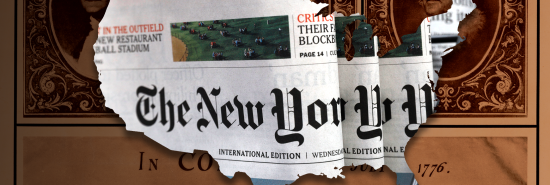
The would-be curators of America whiff it
Eric Felten
The New York Times is never happy just reporting the news. The paper of record doesn’t just like to be the custodian of events. It wants to be the arbiter of the country’s cultural life. Thus the ever-so-important project that dropped this month, in which the New York Times asked its eminent columnists to each pick a single “piece of culture that best captures the country.”
The shtick, of course, is that America is better understood from watching umpteen hours of Survivor than from reading the Declaration of Independence. Ah, the New York Times, where even a little culture commentary stunt finds a way to stick it to the Founding Fathers.
But what do we make of the columnists’ picks?
Some of the choices are embarrassingly obvious. Ross Douthat, for example, chose The Great Gatsby. Why? Because the Jazz Age tale illustrates the proposition that America is a nation on the make. “The basic contrasts of innocence and sophistication, naivete and worldliness are constant American cultural leitmotifs,” Douthat writes. But F. Scott Fitzgerald’s novel “makes the pursuit of even illegally obtained money into a terrain of innocence, where purity of intention covers a multitude of sins.” That’s almost as incoherently highfalutin as what you might expect if you asked ChatGPT for a high school Gatsby essay. May I propose that a far better picture of wealth, ambition, class, and ruin, American-style, is to be found in John O’Hara’s debut novel, Appointment in Samarra. Alas, nobody reads O’Hara anymore.
Farhad Manjoo chooses South Park for its gleeful nihilism. I don’t think he’s wrong that the extravagantly vulgar cartoon series captures the moment. I do wonder, however, whether “nihilism” is quite the right word for describing the show’s attitude and effect. I find the show to be a sort of Shakespearean fool, the jester who, through his outrageous behavior, makes room to speak truth, even to a king. The fool isn’t nihilistic; indeed, he may be the only player on the stage who cares enough to take bawdy chances.
Maureen Dowd looks to the Invasion of the Body Snatchers to explain how we’ve all become “pod people.” You get a cookie if you can guess what malign influence has snatched away the good people of America.
Tressie McMillan Cottom finds that a very different sort of entertainment, the TV series Ted Lasso, is also a warning about Trump’s toxic masculinity. Once Tressie is off after Trump, she manages this odd nonsequitur in the middle of her Lasso essay: “CNN is so eager to bring back Trump’s misogyny opera that it hosted him for a 70-minute town hall a few days before Mother’s Day.”
“Let’s not pretend we’re living through good times,” laments David Brooks. He strives mightily to convince the reader that when he feels low, he turns to bluesman Blind Willie Johnson for solace. Yes, and when Kid Rock has got the blues, he cranks up Brahms’s Second Symphony.
Zeynep Tufekci holds up Breaking Bad as a commentary on America’s lack of universal healthcare. Charles Blow celebrates the Sugarhill Gang’s “Rapper’s Delight.” Bret Stephens gives Pulp Fiction a strained shoutout as a story, if a nonlinear one, of all-American redemption.
Though the all-star columnists of the New York Times cite movies, novels, TV series, and music, none of them seem interested in the visual arts. No one mentioned a painting or a work of sculpture. Architecture was right out.
And no one mentioned a martini. Let me correct that oversight. I am going to enjoy my cocktail while I listen to Frank Sinatra recorded live with the great Count Basie band. And just to be contrary, I believe I will read the Declaration of Independence while I do.
CLICK HERE TO READ MORE FROM THE WASHINGTON EXAMINER
Eric Felten is the James Beard Award-winning author of How’s Your Drink?
